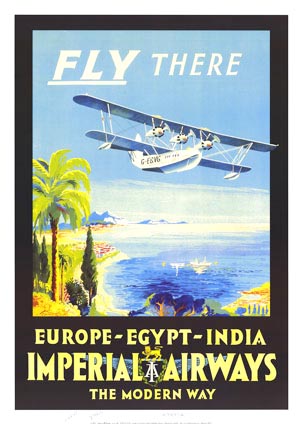
A follow-on of sorts to a recent post.
Imperial Airways was Britain’s main international airline between 1924 and 1939. It enjoyed semi-official status, as it was subsidised by the British government, and had the contract to deliver air mail throughout the Empire. Another international airline was formed in 1935, British Airways,1 which serviced European routes (and it was apparently subsidised as well, at least for the London-Paris route). Imperial did too, but only it flew the long-distance routes to South Africa, India, Hong Kong, Australia (with help from QANTAS) and points in between. I’m not sure if this was an official monopoly, or just because it was difficult to compete over such long distances without subsidies. I also wonder what would have happened if the Imperial Airship Scheme had gone into operation — would Imperial have run that too? Anyway, in November 1939, Imperial and British were merged into BOAC, the British Overseas Airways Corporation.
Imperial had a reputation for flying slow, doddering old planes (the H.P.42 was its mainstay throughout the 1930s, scorching the skies at 120 mph). David Edgerton quotes an MP and pilot — the endnote says W. Perkin, but I think it was W. R. D. Perkins, a Tory and vice-president of BALPA2– as saying:
Imperial Airways services in Europe are the laughing stock of the world … when I am sitting in some distant aerodrome in Europe in the summer and a kind of Heath Robinson machine descends from the skies and everyone begins to laugh, I feel thoroughly ashamed.3
Perkins seems to have been a real thorn in the side of Imperial — shortly afterwards he introduced a private member’s bill alleging gross mismanagement by the airline and the Air Ministry, producing a ‘really thrilling debate’4 according to The Times’s parliamentary correspondent and leading, it seems, to the Cadman commission into civil aviation. British Airways had a more up-to-date image, but was often forced to look to American and German manufacturers for its aircraft. (When Neville Chamberlain arrived back at Heston with ‘peace in our time’, it was in one of British Airways’ Lockheed Super Electras.) Rearmament was partly to blame, as the main suppliers of the Imperial fleet turned to producing Hampdens and Sunderlands instead of airliners. Imperial was finally re-equipping with modern aircraft (Empires, Ensigns and Atalantas) when the war broke out.
Imperial had some defenders in the letters columns of The Times, including Alan Cobham and Nigel Tangye. But it clearly also had a pretty classy advertising department to call upon. The image at the top of the post is from ca. 1930 (the Calcutta it depicts entered service in 1928). Flying boat soars majestically over idyllic tropical beach. Flying there is, it assures us, ‘The modern way’. The following poster is even more striking. It doesn’t even need to advertise the name of the airline (though I guess it may have put produced on behalf of the Egyptian Marketing Board or equivalent — still, it’s definitely an Imperial H.P.42).
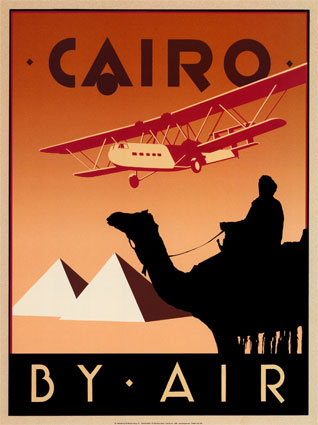
This next one shows air travel as an elegant, refined travel experience, with well-off passengers being served apéritifs by a uniformed waiter, possibly after having seen their inflight movie — the first ever was The Lost World, on an Imperial service to Paris in 1925. According to Wikipedia, anyway. (Not shown: passengers regurgitating the contents of their stomachs due to the turbulence of flying through the lower atmosphere.)
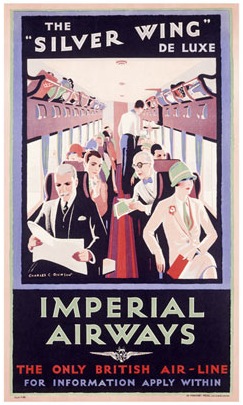
It helpfully notes that Imperial is ‘The only British air-line’ (so before 1935). After all, who would want to trust their lives to foreigners, what?
Imperial’s newspaper ads were not quite as beautiful, but still had good arguments to make.
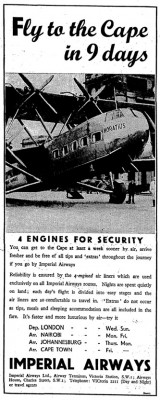
‘Fly to the Cape in 9 days’ doesn’t sound particularly fast, but it was at least a week faster than by sea. Even better, the waiters didn’t need to be tipped!
Reliability is ensured by the 4-engined air liners which are used exclusively on all Imperial Airways routes. Nights are spent quietly on land; each day’s flight is divided into easy stages and the air liners are so comfortable to fly in. ‘Extras’ do not occur as tips, meals and sleeping accomodation are all included in the fare. It’s faster and more luxurious by air — try it
This next ad also stresses the safety factor of having four engines. Indeed, the H.P.42s did have a good safety record — of the eight built, only one was lost before the war, and that to a hangar fire (amazingly, all the other seven were destroyed in 1939-40).
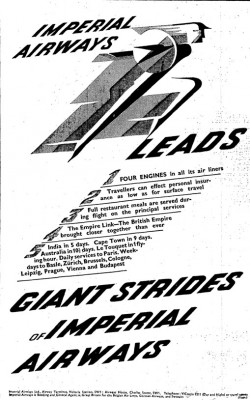
The last ad is for air mail, not air travel. Only sixpence for a letter to Malaya — seems quite reasonable, though it was then 1/3 to get to ‘Australia, New Zealand and Tasmania’:
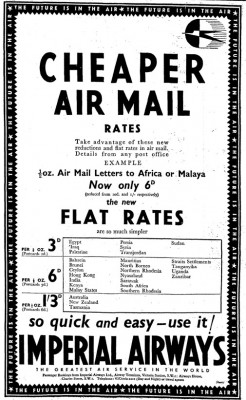
It also claims that Imperial was ‘The greatest air service in the world’. The American News Week (I assume this is Newsweek) at least agreed that it was one of the greatest, praising its pilots and engineers as well as the British air mail service generally.5 The statistics for commercial flights in the first half of 19346 seem to tell another story:
| Country | Route miles | Miles flown | Passengers carried | Goods carried (tons) | Mails carried (tons) |
|---|---|---|---|---|---|
| Great Britain | 13719 | 1163428 | 25505 | 327 | 103 |
| United States – home | 24878 | 17723665 | 191088 | 409 | |
| United States – foreign | 19359 | 3793993 | 50684 | 293 | |
| Germany7 | 22092 | 2930000 | 49971 | ||
| France | 21295 | 3480010 | 26230 | 856 | 263 |
| Italy | 8797 | 1278945 | 17596 | 331 | 72 |
| Netherlands8 | 19853 | 30718 | 561 | 115 | |
| Brazil | 8163 | 370906 | 3540 | 14 | 25 |
Well, OK, technically it was one of the world’s great air services, but fifth place, behind the Netherlands, does not seem very impressive. Still, who can think poorly of an airline which flew these magnficent machines?
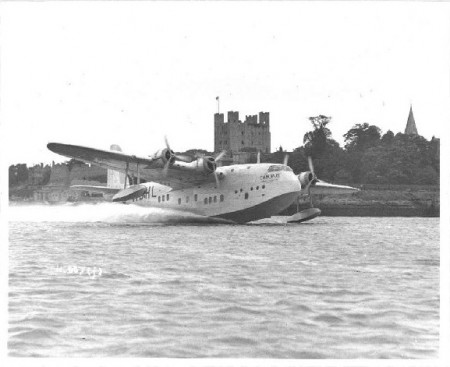
Image sources, in order: AllPosters.com; AllPosters.com; AllPosters.com; The Times, 31 May 1935, p. 44; The Times, 4 June 1935, p. 15; The Times, 5 December 1934, p. 13.
![]() This work is licensed under a Creative Commons Attribution-NonCommercial-NoDerivatives 4.0 International License.
Permissions beyond the scope of this license may be available at http://airminded.org/copyright/.
This work is licensed under a Creative Commons Attribution-NonCommercial-NoDerivatives 4.0 International License.
Permissions beyond the scope of this license may be available at http://airminded.org/copyright/.
- Not the current BA, though they are related. [↩]
- ObPythonRef. [↩]
- House of Commons Debates, vol. 329, 1937/8, col. 431; quoted in David Edgerton, England and the Aeroplane: An Essay on a Militant and Technological Nation (Basingstoke and London: Macmillan Academic and Professional, 1991), 32. Looks like the debate took place on 29 October 1937. [↩]
- The Times, 18 November 1937, p. 14. [↩]
- Nigel Tangye, letter, The Times, 1 November 1937, p. 10. [↩]
- “Commercial aviation in Great Britain”, Round Table 25 (June 1935), 479. [↩]
- Deutsche Lufthansa only. [↩]
- Including Netherlands East Indies. [↩]

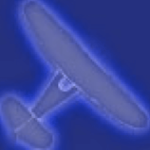
in Chasing After Danger, Terence O’Brien provides a wonderfully vivid account of his journey from Australia to England in an Imperial Airways seaplane at the outbreak of war. He rushed to the UK because he was worried that he was going to miss all the war’s action, having been a plantation overseer on a sleepy Pacific island called Guadalcanal … the book (and its sequels Out of the Blue and The Moonlight War) describe his service first in Coastal Command, and later as one of the RAF Special Duties pilots supporting Chindit ops in Burma. Last time I checked Terence was still very much with us and was an occasional contributor to the old WWII usenet newsgroup, incidentally.
Brett, I’ve always been enthralled with Imperial Airways and wonder if you’ve read Alexander Frater’s Beyond the Blue Horizon: On the track of Imperial Airways (Heinemann, 1986). Wonderful stuff.
Those early pioneering airline outfits were impressive. I enjoyed reading the Fly to the Cape in 9 days bit (no overnight flight from London to Cape Town in those days). Clearly, pervaying a sense of safety was important ‘4 engines for extra safety’.
The merger of Imperial and British Airways was curiously recapitulated in 1976, when BOAC merged with British European Airways to form the BA we know and love – BEA was the post-war equivalent of pre-war British Airways. Curiously the divide continues to this day – BA traditionally makes money on long haul (=ex-BOAC) and loses it on European operations (=ex-BEA), and there are plenty of old Nigels who will tell you that it all changed for the worse when BEA was added.
BOAC brought its call sign to the wedding, hence BA flights are known as “Speedbird [flight number]”.
And yes, those flying boats were wonderful. Interestingly, BA’s arch-competitor Virgin Atlantic still advertises “4 Engines 4 Long Haul”.
Oh yes, and something else: aviation and Modernism. Imperial Airways was a patron of Laszlo Moholy-Nagy when he was in exile in London in the 1930s. They commissioned him to design adverts, a route map, and a timetable, all of which were in last year’s retrospective at the Tate Modern. He als designed posters for London Transport.
Glad you mentioned the Sunderland, Alex, because I was going to make some thoroughly disparaging remarks about the HP42 in relation to the sophistication of plane at the beginning of this clip:
http://www.youtube.com/watch?v=oo3YlNWdqoo
There is something quite attractive about the HP42, though. Probably the Heath Robinson of it all.
And you’ll probably love this:
http://www.youtube.com/watch?v=4Wl42l9dMZc
Those statistics don’t mention Australia (and Territories). I don’t have figures but the tonnage on the Lae-Wau route alone at that time was pretty large probably several thousand tons a year. Everthing to Wau went by air not just 3,000 ton dredges.
Clipper beats H.P.42. Sunderland beats Clipper. But Empire beats them all, IMHO.
I agree that there’s something about the H.P.42. I think it’s two things, firstly the juxtaposition of fairly streamlined fuselage with biplane wings, and secondly the sheer size of the whole thing. We are used to thinking of biplanes as small, unstreamlined aircraft, so it makes an impression.
Oh, and since Alex mentioned Modernism, Le Corbusier seems to have been a fan of the H.P.42. At least, he included a very striking photo of one (from behind one of the wheels, looking towards the cockpit) in his Aircraft (1935) — it’s reproduced in England and the Aeroplane.
Thanks for the references — another good one for flying boat enthusiasts is Graham Coster’s Corsairville: The Lost Domain of the Flying Boat (2000).
Finally, I have to admit I didn’t know what jc was referring to. The answer is this. Pretty impressive stuff!
Pingback: Centaurus Acceptance Tests – new voice recordings – White Water Landings